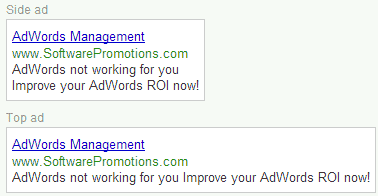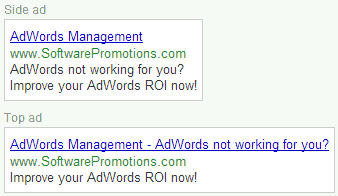After careful detailed analysis, you’ve picked all the right keywords. Anyone searching for them has to be interested in what you are offering.
So why are there so few clicks on any of your ads?
How did you setup your ad groups?
Creating campaigns with one single ad group packed with keywords and ads is not a good idea. This is because your ads need to directly address your keywords.
When someone searches for one of your keywords, they need to see an ad that compels them to click on it. If the keyword used in the search connects with the ad, it is more likely to be clicked on.
With one ad group and a wide range of keywords, it will be difficult to write ads that make those types of connections. This is why it’s important to breakdown your lists of keywords into common keyword themes and then craft your ads around each of those themes.
Are you using your keywords within the ads?
When people perform a search on Google, they’re looking for that keyword within the results. This is why Google highlight those keywords in bold. If you’re not using your keywords in your ads, they can’t stand out.
Are you asking people to do something when they read your ads?
Have a look at your ads throughout your account. Are they just informational or are they compelling people to do something? You want people to click on your ads and do something once they arrive on your website. Saying so will help improve the chances, as well as the performance of your ads.
Are you taking punctuation into consideration?
Depending on how you punctuate your ads, they can be displayed very differently. Take the following ad as an example:
As you can see, I did not use a question mark at the end of the Description line 1. When the ad is displayed at the top of the search results, it will appear differently.
When the Description line 1 contains punctuation at the end, it can become part of the headline when displayed at the top of the search results.
Which way is better will depend on your particular situation. Improper use of punctuation could make the ad more difficult to read.
What are the competitors doing?
AdWords is not about your ad in isolation. Your ad can be displayed right next to a number of other ads for products and services that are identical to yours. Some advertisers face fierce competition, which is why you need to periodically keep an eye on your competitors.
Are their prices being displayed within their ads? Are they offering more compelling deals? Are they using the same keywords?
Understanding what the competition is up to will help you stand out.
Can your potential customers see your ads?
When just dealing with Google Search, ads can be displayed at the very top of the search results, on the side of them or at the very bottom. In some cases, your ads might not even be displayed on the first page of the results. Also, a number of your competitor’s ads might be seen right above your ads. Think needle in a haystack.
Ad positioning is a major factor that needs to be taken into consideration when analyzing your ad performance. Even though your ad received a large number of impressions but no clicks, the ad itself might not be the issue. Your ad might simply be hidden within the search results which means it never had a real chance to compete in the first place.
How many ads have you created?
Writing ads is time consuming and can sometimes be difficult with the various character limitations. I have seen many AdWords accounts that only use one ad per ad group which I feel is too much of a gamble. My approach is to create at least four ads per ad group. Not four almost identical ads but four somewhat different ads that attempt to compete against each other. Then as the data pours in, I pause or delete the poorly performing ads, creating new ad variations based on the winning ads.
It doesn’t stop there.
Keep in mind that this is an ongoing process. Even if you find the winning ads doesn’t mean your work is done.
Ads that work now, might not work in the future and ads that didn’t work in the past might perform much better now.
Keep on experimenting.
Unique ideas for your business
The Demystifier puts practical ideas into your hands. You won't find them elsewhere. Original, actionable and insanely effective.




